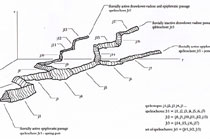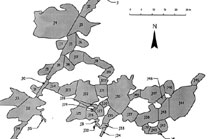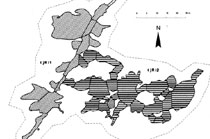The caves represent specific natural geosystems with several special physiognomic features of geographical sphere components, spatial organization and natural processes. The caves are without pedogenetic processes and photosynthesis, and characteristical are special features of biocomponents, speleoclimate, water as a part of hydrosphere and lithosphere with cave georelief in the zone of hypergenesis.
 Cave geosystems are characteristic by spatial (vertical and horizontal) structure (speleotopes, speleochores, sets of speleochores) and time-spatial changes (seasonal regime, dynamics induced by the change of geoecological invariant, evolutional development in geological times). The knowledge on spatial structure and time-spatial changes of cave geosystems are important in dealing with various analytical and synthetical tasks, including environmental problems in karst landscape. The cave geosystems have strong relations with surface landscape systems. From the vertical point of view, it means mainly seepage of rainfall waters, from the horizontal one it means ponor autochthonous or allochthonous water courses.
Cave geosystems are characteristic by spatial (vertical and horizontal) structure (speleotopes, speleochores, sets of speleochores) and time-spatial changes (seasonal regime, dynamics induced by the change of geoecological invariant, evolutional development in geological times). The knowledge on spatial structure and time-spatial changes of cave geosystems are important in dealing with various analytical and synthetical tasks, including environmental problems in karst landscape. The cave geosystems have strong relations with surface landscape systems. From the vertical point of view, it means mainly seepage of rainfall waters, from the horizontal one it means ponor autochthonous or allochthonous water courses.
Many anthropogenic activities influence natural processes, by which is the structure stability of cave geosystems disturbed. Among the most negative anthropogenic impacts belong: pollution of underground waters and damaging or even destroying of cave water fauna by sinking allochthonous water courses polluted by sewage from manure dumps and agrochemicals; seepage of atmospheric waters contaminated by agrochemicals or industrial imissions; disturbing of hydrological regime of seepage rainfall waters due to removing the vegetation cover, floating in soil sediments into cave spaces after deforestation or improper ploughing above the cave or within its catchment area, chemical destruction of dripstone fills by aggressive waters due to anthropogenic impacts, breaking off the flowstone fills, throwing waste into abysses, illegal collection of cave fauna, osteological and archaeological findings. Known are also cases of destroying caves by mining in quarries or at construction of roads. The regeneration capacity of karst landscape including caves is small, and in some cases impossible.

 The self-regulation of cave geosystems and limit values of their resistance are important from the viewpoint of cave protection. On the basis of monitoring of these changes, the attendance of show caves is regulated and limited. Since the karst permeability in soluble rocks is connected with low filtration ability, the self-cleaning process of polluted underground waters is also low and in advanced stage of karstification is almost absent. The stability of speleotopes, speleochores and sets of speleochores is categorized on the basis of hydrological processes character, degree of karst permeability and character of further components of cave environment.
The self-regulation of cave geosystems and limit values of their resistance are important from the viewpoint of cave protection. On the basis of monitoring of these changes, the attendance of show caves is regulated and limited. Since the karst permeability in soluble rocks is connected with low filtration ability, the self-cleaning process of polluted underground waters is also low and in advanced stage of karstification is almost absent. The stability of speleotopes, speleochores and sets of speleochores is categorized on the basis of hydrological processes character, degree of karst permeability and character of further components of cave environment.
Dear visitors, we would like to inform you that due to the technical conditions of payment terminals, there may be situations when card payment will not be possible. For this reason, we recommend that you have an adequate amount of cash available if you want to be sure that you will be able to visit the cave. Thank you for understanding.
Dear visitors, the parking lot doesn't belong to cave administration. The fees are collected by different entity. Thank you for your understanding.